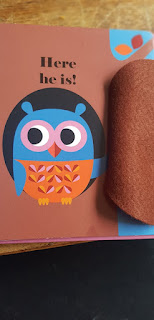Getting in a flap about lift-the-flap books
Yesterday I came across an interesting study which shows that children 2 year olds don't learn vocabulary from lift-the-flap books. The study is:
Shinskey, J. L. (2021). Lift-the-flap features in “first words” picture books impede word learning in 2-year-olds. Journal of Educational Psychology, 113(4), 641–655. https://doi.org/10.1037/edu0000628
Sixteen children were shown a lift-the-flap book with photographs of fruit and vegetables, and another 16 were shown the same book modified to have no flaps. Each child went through the text six times, having the fruit and veg names given for them. The experimenters used starfruit as their key item, teaching the children it was called 'carambola'. Afterwards the children who had seen the no-flap book were significantly better at identifying 'carambola' from a choice of images or a choice of fake food items. There was no difference, however, between their ability to choose the higher frequency food items. The researcher concludes that the flaps interfere with the children's learning of vocabulary.
Now, this is quite a small experiment, but it has a fairly convincing design, and it has an interesting outcome. One of the reasons photographs were used is because previous research has shown that toddlers learn more 'about the world' from photographs than drawings. I thought I would blog about it because although I'm not an early reading specialist, I do have two small children (about to be 1 and about to be 4), an absolute shedload of pre-school books, and some knowledge about the topic. Also, I think this is an interesting study for the point of view of Child Lang Acquisition study for A level language.
So - does this mean we should stop reading lift-the-flap books with our two year olds?
My answer to this is a fairly unequivocal 'no'. I am not convinced that the primary aim of reading any book with a small child acquiring language is to teach vocabulary. And I don't think I have ever seen a lift-the-flap book which was photographic rather than illustrated, despite the extensive collection we have acquired over the last few years.
My NQ4YO (not quite 4 year old) has largely moved on from lift-the-flap books now, but enjoyed them hugely as part of a range of texts when he was smaller. Reading a lift-the-flap book often was more about the flap than the words when he was two, particularly those like 'Where's Mr Owl?' which cover pictures of animals with felt flaps, as opposed to the story ones like 'Dear Zoo' or 'Dear Santa' where the picture replaces a word in the text altogether. Lift-the-flap books taught him that books were engaging and fun, and that they were something to be interacted with, rather than administered to him by an adult. As he developed, he learned to delay the flap until the right words had been read, thus delivering an important lesson about the way that stories are structured, and the relationship between text and illustration. Books like 'Dear Zoo' where we had to supply the word made the experience of reading one where adult and child talked about the content of the book, instead of one just delivering it to the other. This didn't just teach him about how reading, books, enjoyment worked, or develop a productive dynamic between the two of us (or between him and his father, who reads as many, if not more books with him than I do). It also taught me about reading with a small child. It's not just about delivering the story: it's about the conversation it engenders, experiencing the emotions together, having a chat. When we (and I'm using the collective we to mean parents and teachers here) lift the flap we don't just read the word and match the picture like a flashcard; we also ask the child what the picture is of, utilising retrieval practice and repetition in a way you wouldn't with a controlled experiment.
Reading with small children is not entirely or even, I would argue, primarily about teaching them vocabulary items. Reading with small children is about developing a positive relationship with books, and with adults with books. I wouldn't have wanted all the books to be lift-the-flap but among a range of other texts their place is justified despite this research.


Comments
Post a Comment